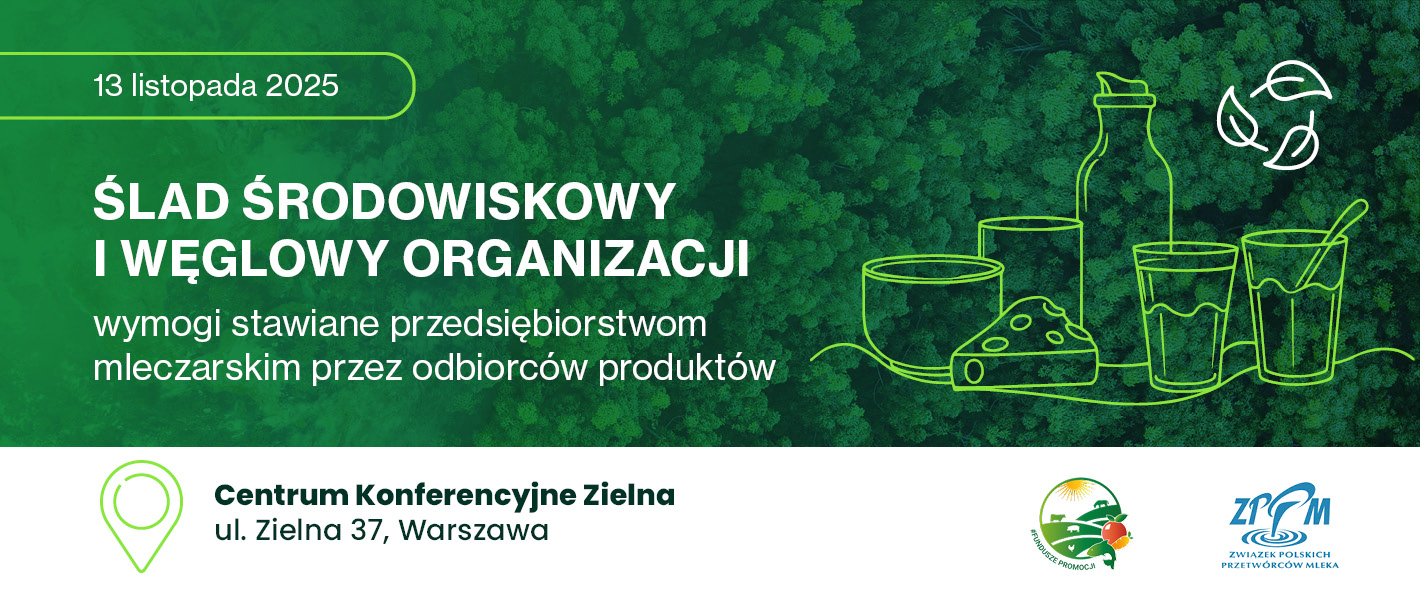ECONOMY
- Impact of the „Farm to Fork” Strategy on the Dairy Sector Development (DOI10.15199/65.2021.10.1)
Piotr Szajner 4
The „Farm to Fork” strategy defines the conditions for the functioning of the EU agri-food sector, including the dairy industry. The Polish dairy sector is relatively well prepared to implement the strategy, which, however, will be a big challenge, as farms and the dairy industry would have to carry out a substantial modernization process. The strategy creates opportunities for the sector as well as development threats. The opportunity is undoubtedly the restructuring of the sector towards a circular economy model, which will generate social and economic benefits and will have a positive impact on the environment and climate. The implementation of the strategy will require an adjustment and modernization processes, which may result in an increase in the costs of milk production and processing as well as the prices of dairy products. As a consequence, the affordability of products and the sector’s competitiveness on the foreign markets may deteriorate.
KEY WORDS: milk, dairy industry, strategy, sustainable agriculture
- Polish Grain Market over the Period of 2010-2020 (DOI10.15199/65.2021.10.2)
Wiesław Łopaciuk 11
The paper analyses the changes on Polish cereal market over the period of 2010-2020, when earlier changes in the world agricultural markets resulted in certain effects on the domestic market. The EU reformed its policies (CAP) so as to reduce of the scope of the support and link it with actions aimed at the environment protection. The Polish cereal market was featured with accelerating production concentration processes. Nevertheless, the agrarian structure of cereal producers in Poland is still fragmented and polarised, with a small group of specialised large farms on one hand and numerous small farms on the other. The importance of the first group (in terms of land held and share in production) is constantly growing, increasing the overall level of technology applied, and thus yields and crops. The increase in production with relatively small changes in demand resulted in permanent surpluses and strengthened position of a net exporter. Structural changes among cereal producers favour cereal processors, particularly in the milling, feed, distillery and malt industries. The growing concentration of production means lower transaction costs for the purchase and transport of grain.
KEY WORDS: Poland, grain market, demand, supply, production, cereal balance sheet, producers’ structure
- Impact Of the Coronavirus Pandemic on The US Food Market and Catering (DOI10.15199/65.2021.10.3)
Bohdan Achrem-Achremowicz 20
The second-year pandemic has caused significant changes to the activities of the food and catering industry around the world. Lockdown and mobility restrictions have driven a demand for products suitable for immediate consumption or quick preparation for consumption at home.
The largest American food industry in the world adjusts the scope of production to the observed needs. In the period 2020-21 in the United States, the introduction of new products decreased by approx. 30% compared to the national average for years 2017-2019. Restaurants have reduced the menu, introducing more take-away and semi-finished products for home use. Examples of new food products are given, the production of which in pandemic time can be quickly sold in the domestic market and for export.
KEY WORDS: coronavirus, USA, food industry, gastronomy
TECHNICS-TECHNOLOGY
- Application Of Laser Diffraction to Study Stability of Oil-In-Water Emulsions in The Dairy Industry (DOI10.15199/65.2021.10.4)
Adrianna Bomba, Andrzej Babuchowski, Marek Adamczak 25
The physical stability of emulsions in case of food products is a parameter closely related to consumers’ acceptance, as well as one of the most important determinants of the products’ shelf life. Thermodynamic stability determines the conditions of storage and transportation of manufactured goods. Therefore, the research on emulsion physical stability is an important part of industrial research. This topic is of particular importance for dairy industry, where the raw material is milk – a classic example of oil-in-water (o/ w) emulsion. The analytical methods used so far to determination the stability of o/w emulsions’ have been based on the analysis of the size of fat globules using an optical microscope: PN-A-86059: 1975. However, scientific and technical progress has led to the obsolescence of the quoted standard, which lost the status as the „recognized technical rule” and was withdrawn without replacement. Currently, the stability of o/w emulsions, determined by the fat globules’ size distribution is being studied by means of laser diffraction.
KEY WORDS: optical microscopy, laser diffraction (LD), particle size distribution (PSD), emulsion stability
- Ricotta Cheese – Production, Characteristics and Quality Features (DOI10.15199/65.2021.10.5)
Iwona Chwastowska-Siwiecka 32
Ricotta is a dairy product made from whey, a mixture of whey and milk or cream, by acid and heat coagulation. It is mostly popular in Italy, Greece, and also in the United States and Argentina, where it is made from cow’s milk only. The whey used in the production of ricotta cheese comes from sheep, cow, buffalo and goat milk. There are several methods of producing acid-head coagulated cheese depending on the raw material, its initial and final pH and heating temperature. The most important parameters for obtaining correct cheese features are: pH during coagulation, type of acid used, whey heating method, the heating temperature and time, as well as presence of calcium ions. Due to its nutritional and organoleptic properties, ricotta cheese is widely used as an ingredient of many dishes served both sweet and salty. In Italian cuisine, it is an ingredient of ravioli, lasagne or pancakes.
KEY WORDS: ricotta cheese, production technology, quality features, cold storage
- Cheeses From Microbes? (DOI10.15199/65.2021.10.6)
Małgorzata Ziarno, Dorota Zaręba 45
For many years, a discussion has been in progressing whether laboratories will enable the production of animal food without the need to use animal organisms. The already well known vegetable replacements and substitutes of meat or dairy products, as well as plant honey, eggs, and fish substitutes. We have reconciled with the admission of proteins from insects to humans’ food supply. Recently, a new possibility has appeared – microbiological substitutes for dairy products such as cheese. Mycoproteins, i.e. proteins obtained with the help of naturally occurring microscopic fungi, are already implemented in the production practice as an excellent raw material to obtain a microbiological substitute for a creamy cheese. In recent years, progress in biological and IT technologies have allowed for the development of precision fermentation towards designing biosynthesis of casein and whey proteins, as well as their use together with components of plant origin for the production of vegan cheese replacements without the use of animal organisms.
KEY WORDS: single cell proteins, mycoproteins, dairy replacements, precision fermentation, transgenic proteins
- Shaping the Quality and Safety of Minimally Processed Food (DOI10.15199/65.2021.10.7)
Iwona Szymańska, Iwona Ścibisz 52
The dissemination of knowledge about the relationship between the health condition and the diet has resulted in an increase the demands placed on food by the modern consumer, who is increasingly looking for products with high nutritional value, as well as those that are easy and quick to prepare for consumption. This resulted in the development of unconventional preservation techniques and packaging methods, which allowed producers to increase the amount and type of minimally processed food assortment offered. The use of mild preservation methods causes that the food has a limited shelf life, which results not only from the activity of microorganisms, but also from the physiological and biochemical processes taking place in the products. Due to the low degree of processing, these foods require refrigerated storage and an effective packaging system adapted to the type of product, which will ensure a sufficiently long shelf life.
KEY WORDS: minimally processed food, microbiological safety, storage, packaging, fruit and vegetables
FOOD-FEEDING
- Consumer Assessment of Ripening Cheeses Made of Cow’s Milk (DOI10.15199/65.2021.10.1)
Barbara Krzysztofik, Barbara Krochmal-Marczak 60
The aim of the study was the consumer evaluation of ripening cheeses made of cow’s milk. The ripened cheeses with Protected Designation of Origin and Protected Geographical Indication were assessed. The research material consisted of 4 European, regional ripening cheeses: Italian (Parmigiano Reggiano DOP), English (Cheddar DOP), Swiss (Emmentaler AOP), and Polish (Ser Koryciński Swojski – PGI).
According to the evaluators, the obtained quality profiles of individual cheeses showed that the most important organoleptic value turned out to be the evaluation of the flesh, i.e. no eyeleting or its lack in the structure of the discussed cheeses, this fact was very highly rated (4.90 – 3.30 points), and then flavored. As it results from the research in long-ripening cheeses, the value of the total quality index (WJC) oscillated between 4.69 – 4.57 points, which proves their high organoleptic value, while the WJC value of fresh cheese, aged 4 days was 2.82 points.
KEY WORDS: cheeses, organoleptic evaluation, quality index
EVENTS
- Pascalisation in the context of global trends in the food ndustry 10
- POLAGRA – summary of the 2021 dition 17
- The innovative analysis of intramuscular fat in meat 28
- The great return of einkorn and other traditionally Polish cereals 57
- The BIOEXPO 2021 Congress is behind us! 66
- Packaging waste segregation 67




